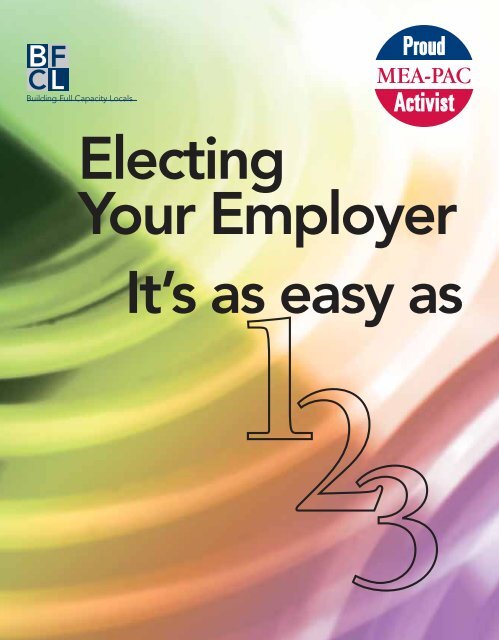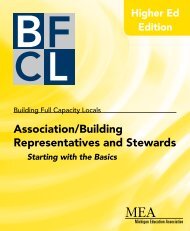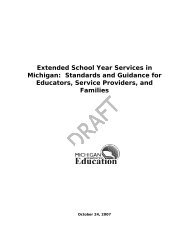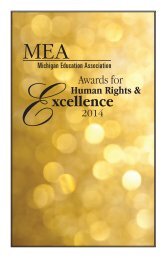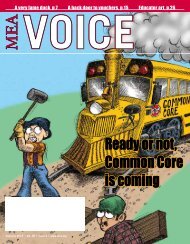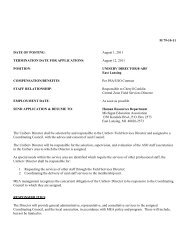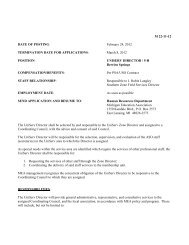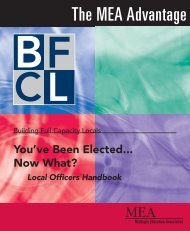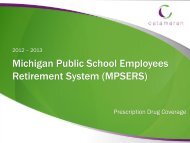Electing Your Employer - Michigan Education Association
Electing Your Employer - Michigan Education Association
Electing Your Employer - Michigan Education Association
Create successful ePaper yourself
Turn your PDF publications into a flip-book with our unique Google optimized e-Paper software.
Building Full Capacity Locals<br />
<strong>Electing</strong><br />
<strong>Your</strong> <strong>Employer</strong><br />
It’s as easy as<br />
1
School<br />
Dear Local Leader,<br />
“<strong>Electing</strong> <strong>Your</strong> <strong>Employer</strong>,” is a political activity that closely touches all of your members.<br />
Policies made by local school boards have a direct effect on your members’ salaries, benefits<br />
and working conditions, as well as the learning environment and learning tools for your<br />
students.<br />
Getting involved in school board elections is an opportunity for your members to see their<br />
PAC dollars at work and to help shape public education in your school district. Thus, it is the<br />
most important local election for our members to actively support pro-public education<br />
candidates. By recommending, campaigning and voting for candidates in school board<br />
elections, your members are truly “ImPACting the Future” and the future of public education.<br />
One out of every 50 <strong>Michigan</strong> citizens is either a current or former MEA member. MEA<br />
members, their families and friends can be the deciding factor in these elections.<br />
Taking an active role in school board races is the easiest way to influence those who make the<br />
decisions in your school district. Get involved. Participate. You will make a difference!<br />
Help shape the future of your school district. Elect your employer. It’s as easy as 1, 2, 3—if you<br />
have commitment and a plan.<br />
Request copies of this resource booklet along with other materials and information by<br />
contacting MEA Field Services 800-292-1934, ext. 2941 or by downloading at<br />
http://www.mea.org/bfcl<br />
Full capacity locals DO imPACt the future!<br />
1
Planning and Implementing a Successful<br />
School Board Election Strategy<br />
Building the Foundation<br />
• Union representatives should attend all school board meetings.<br />
• Be aware of who attends board meetings and their issues.<br />
• Get to know interested and cooperative citizens who are union friendly.<br />
• Form and maintain coalitions with internal unions.<br />
• Build relationships with other unions—become active in a local labor council.<br />
• Be aware of each board member’s term limit.<br />
• Listen for rumors of who may run—both incumbents and others.<br />
• Be on the lookout for possible candidates from the union perspective.<br />
• Develop year-long PR program.<br />
School Board Attendance Report Form<br />
Date _______________________________________________________________<br />
Attended by board members: ____________________________________________<br />
____________________________________________________________________<br />
Administrators: ________________________________________________________<br />
____________________________________________________________________<br />
Others in attendance: __________________________________________________<br />
____________________________________________________________________<br />
Attach agenda.<br />
Who spoke on what issues?<br />
Citizen participation:<br />
Who:<br />
Topic:<br />
Closed session: Yes No<br />
3
School Board Attendance Schedule<br />
President or Vice President <strong>Association</strong> Representative/Officer<br />
July __________________________________ ____________________________________<br />
August __________________________________ ____________________________________<br />
September __________________________________ ____________________________________<br />
October __________________________________ ____________________________________<br />
November __________________________________ ____________________________________<br />
December __________________________________ ____________________________________<br />
January __________________________________ ____________________________________<br />
February __________________________________ ____________________________________<br />
March __________________________________ ____________________________________<br />
April __________________________________ ____________________________________<br />
May __________________________________ ____________________________________<br />
June __________________________________ ____________________________________<br />
4
Research<br />
Election Questions:<br />
• What is the current makeup of the board?<br />
• Who are the current board members?<br />
• Who is running? Are they running as incumbents? Running against incumbents?<br />
• Did MEA recruit anyone?<br />
• What is the school board history?<br />
• Is there a big issue that is motivating people to run?<br />
• Are there controversial issues going on in the district?<br />
• Are your contracts up soon?<br />
• What has been the relationship with the board and the bargaining units?<br />
Getting to Know the District<br />
Before beginning a campaign for any office, you should become acquainted with<br />
the election district and its voters. Maps of the school district boundaries will help<br />
establish the terrain and can be obtained from the local school district.<br />
Who Lives in the District?<br />
1. Are they mainly white collar or blue collar?<br />
2. Do most rent or own their own homes?<br />
3. Are they mainly upper, middle or lower on the economic scale?<br />
4. Is there any dominant ethnic group?<br />
What Are the District’s Political Habits?<br />
Voter registration lists (Qualified Voter File) and past election statistics are available from<br />
many school districts and the county clerk’s office. From those sources you can determine<br />
the following:<br />
1. How many registered voters?<br />
2. How many voters vote in school board elections?<br />
3. How many women, men and seniors vote in school board elections?<br />
4. How many absentee ballot voters are in the district?<br />
From that information you can make judgments about:<br />
1. How many votes will it take to win? (50% + 1)<br />
2. From where are the votes likely to come?<br />
3. From where are new voters likely to come?<br />
5
Sample FOIA Request Letter for the<br />
Qualified Voter File (QVF)<br />
Date<br />
Mr. County Clerk<br />
Any County<br />
Address<br />
RE: FOIA Request<br />
Dear County Clerk:<br />
Pursuant to the <strong>Michigan</strong> Freedom of Information Act (M-FOIA) I request a copy of the<br />
Qualified Voter File (QVF) sorted by precinct for the Any City Public School Board Elections<br />
for the following years: 2006, 2005, and 2004. Please include the voting record and address<br />
of each voter in the QVF. Providing this information in an electronic format is acceptable.<br />
Please contact me if you have any questions regarding this request. Thank you in advance<br />
for your prompt response to this request.<br />
Respectfully,<br />
Local EA/ESP President<br />
Qualified Voter File Request Form<br />
Provided by the Bureau of Elections<br />
See Appendix A.<br />
6
Selecting a Candidate<br />
Candidate Recruitment<br />
Candidate recruitment must be an ongoing process – Keep a list<br />
What to look for:<br />
• What are the characteristics of an ideal candidate?<br />
• Gender makeup of board could make a difference.<br />
• Know your candidate(s).<br />
• Don’t take anyone for granted.<br />
• Don’t leave it to chance. You don’t want the best of a bad bunch!<br />
• Know your issues and be sure the candidate(s) understands them.<br />
• How will your candidate, when elected, stand up to opposition? (Key Question)<br />
• Are they electable? Name recognition/credibility, community involvement.<br />
• Do they have an axe to grind?<br />
• Don’t overlook MEA family members, spouses or other union members.<br />
• Make sure the candidate will run to win and use your help.<br />
Critical qualities of a school board candidate:<br />
1. Must understand and value the role of teachers and support staff.<br />
2. Must recognize that teachers and support staff are critical factors in the “education machine.”<br />
3. Must value relationships and the honest and fair exchange of ideas.<br />
4. Recognizes a school system as a human service agency vs. a big business. Must clearly<br />
understand the differences inherent in each.<br />
5. Views the role of “leader” as one who pulls a system together to get the best collective<br />
performance from the whole. (Listens, cooperates vs. the “boss with all the answers”).<br />
6. Understands and appreciates the merits of unionism.<br />
7. Understands, respects and has had experience with collective bargaining.<br />
8. Values your support, seeks your opinion.<br />
9. Must have strong sense of self-confidence. No need to get star-status from board<br />
membership.<br />
10. Understands the current issues facing your school system.<br />
Look for: Respect for teachers and support staff, openness, values opinion of others, flexible<br />
thinker, willingness to change views and opinions, honesty about own strengths and<br />
weaknesses.<br />
Look OUT for: Controlling personalities, stubborn attitudes, inflexible thinkers, folks who<br />
perceive this role as a status builder.<br />
7
Who Makes a Good Candidate?<br />
Personal attributes<br />
1. Reputation for integrity and hard work.<br />
2. Calm temperament.<br />
3. Ability to think quickly.<br />
4. Willingness to admit ignorance rather than give a poorly considered answer.<br />
5. Background that can bear scrutiny.<br />
6. Leadership skills.<br />
7. Ability to handle criticism and/or lack of support whether by family or friends.<br />
8. Friendly manner and adequate social skills.<br />
9. Good speaking voice.<br />
10. Capacity for listening.<br />
11. Philosophy that time and energy expended will be recouped through personal<br />
satisfaction and growth.<br />
12. Ability to empathize with voters’ concerns and issues and a respect for the wishes of the<br />
constituency.<br />
Legal qualifications<br />
There are some legal qualifications that a candidate must meet under the <strong>Michigan</strong> School<br />
Code. A candidate must:<br />
1. Be a citizen of the state.<br />
2. Have good moral character.<br />
3. Be 18 years of age.<br />
4. Be a resident of the district.<br />
5. Not be employed by the district.<br />
Candidates must keep in mind the legal regulations regarding running for public office.<br />
A candidate may file nominating petitions or pay a $100.00 nonrefundable fee. Nominating<br />
petitions must be signed by registered voters living in the school district. Petition signatures<br />
requirements are as follows:<br />
School District Population less than 10,000 – 6 to 20 signatures needed.<br />
School District Population 10,000 plus – 40 to 100 signatures needed.<br />
Candidate must also file an Affidavit of Identity (Appendix B) with the designated clerk no<br />
later than 4 p.m. on the 12th Tuesday prior to the date of the election.<br />
Beyond the legal requirements, the desired characteristics vary with local conditions.<br />
However, two points are clear:<br />
1. The candidate must be acceptable to a sufficient number of voters to be able to win.<br />
2. The candidate supported must be acceptable to your membership.<br />
8
Potential Candidates—Where to Look<br />
• Members of other local governing bodies.<br />
• Faculty members at the local college.<br />
• School employees living in your district but employed by another school district.<br />
• Former or retired school employees. (Do not assume that any teacher or educational<br />
support staff will agree with you on all issues or that all school employees would be good<br />
school board members.)<br />
• Members or officers of local industrial unions and particularly of unions with which the<br />
MEA/NEA has had some relationship or with which your local association has cooperated<br />
in the past.<br />
• Parents of children attending the schools can be identified at PTA or PTO meetings and<br />
especially at school board meetings and they may make excellent candidates.<br />
This is by no means an exclusive list of possible sources of potential candidates. But from<br />
among these and other similar sources that you identify, your local association should find<br />
somebody who is acceptable, electable and able to be motivated to run. The rewards for<br />
service on the school board are less than exhilarating; but from the groups suggested<br />
above, find persons with either a demonstrated desire, or an issue, or an ideological<br />
motivation to serve on a school board. Of course, no matter where your local association<br />
seeks a candidate, be selective.<br />
Write-In Candidates<br />
Choose to run a write-in candidate as a last resort!<br />
This may become necessary if you haven’t been able to recruit a candidate before the filing<br />
deadline. One can file to be a write-in candidate up until 4 p.m., the Friday preceding<br />
the Tuesday election. Write-in candidates must file with the designated clerk by completing<br />
the Write-In Candidate Declaration of Intent form and a Statement of Organization for<br />
Candidate Committees.<br />
<strong>Your</strong> elections committee will follow the basic campaign plan with timeline modifications.<br />
Write-in candidates should be interviewed and screened, just as all other candidates.<br />
If the candidate files his/her Candidate Declaration of Intent (Appendix C) after absentee<br />
ballots are mailed, you will miss a group of voters that you often count on for support.<br />
For write-in candidates, seek volunteers to work outside the polling sites on Election Day.<br />
The volunteers will hand out labels to voters to attach to the ballot in the write-in candidate<br />
space.<br />
Do everything for the write-in candidate that is done for a candidate that filed before the<br />
filing deadline.<br />
9
Screening & Recommendation Process<br />
Screening and Recommendation Process<br />
Timeline<br />
Second week of February/August—Filing deadline. S & R committee should be appointed<br />
and have a good understanding of assignment.<br />
Third week of February/August—Develop data sheet and questionnaire.<br />
Last week of February/August—Send out interview times along with data sheet and<br />
questionnaire. Confirm all interviews. President drafts an information letter to MEA<br />
members.<br />
Last week of February/August—Develop interview questions.<br />
First week of April/September—All interviews completed and recommendations made.<br />
Second week of April/September—Send letter to membership to inform them of<br />
recommended candidate(s).<br />
The Candidate Questionnaire<br />
The traditional format for a Candidate Questionnaire consists of open-ended questions,<br />
questions that seek to determine the candidate’s position on an issue, and questions that<br />
ask the candidate to set priorities. Another format takes issues important to the local<br />
association and formulates them into statements.<br />
Begin the screening process by mailing a questionnaire to each of the candidates for their<br />
completion.<br />
Strike from your list those candidates who do not respond to your questionnaire or to a<br />
follow-up telephone call.<br />
Invite candidates to meet with the local association for an interview. At these meetings,<br />
thoroughly explore each candidate’s qualifications and views on the issues identified as<br />
important to school employees, students and voters of the district. Make no assumptions.<br />
Question your friends as thoroughly as you question the candidates you do not know<br />
personally.<br />
10
Candidate Interviews Tips<br />
Interviewing candidates takes time, preparation and coordination. But if the activity is<br />
handled properly it can be a very meaningful experience for all concerned.<br />
1. Inviting Candidates—Give the candidate ample notice of when interviews will be<br />
conducted. Then coordinate with the candidate or campaign manager a date and time<br />
convenient for both you and the candidate.<br />
2. Develop Questions—Prepare a list of questions for the candidate to answer. Make sure<br />
that each question is phrased properly and education issues covered pertain to the office<br />
the candidate is seeking.<br />
3. Submit Questions in Advance—Submit written questions to the candidate in advance so<br />
that he/she will have time to consider responses. In some instances written answers<br />
might be required. Please indicate or separate questions that should be answered in<br />
writing from those answered orally.<br />
At times, only a written questionnaire is used while other times a verbal response is used.<br />
The best method, however, is a combination of both. Keep a permanent file.<br />
4. <strong>Your</strong> Screening and Recommending Committee—The S & R committee should consist of<br />
at least three but no more than five members. Each member should be familiar with the<br />
issues. Provide adequate time for the candidate to answer each question fully. Do not<br />
hurry his/her response and make sure he or she fully understands the question. If the<br />
candidate disagrees with your position, do not attempt to argue over one point or to<br />
attack his/her position on the spot.<br />
Before ending the interview, allow for any closing remarks and questions.<br />
5. The Interview—During verbal interviews, treat all candidates in a friendly, courteous<br />
manner. Never try to trap him or her or create a climate of suspicion. <strong>Your</strong> primary goal is<br />
to find out where the candidate stands on education issues of vital concern to your<br />
group.<br />
6. Avoid Group Interviews—Interview only one candidate at a time.<br />
7. Interviewing Supportive Incumbents (Not to be confused or compared with House &<br />
Senate S & R process)—When interviewing an incumbent candidate who has been<br />
supportive of your program, indicate your appreciation of his/her support. You may want<br />
to spend most of the time with this kind of candidate discussing election concerns and<br />
how your members can be of most assistance in his/her reelection effort. The point here<br />
is that you treat candidates who are incumbents and proven friends of your program<br />
differently from nonincumbents or those candidates who have a very mixed voting<br />
record.<br />
11
Questions for the Board of <strong>Education</strong> Candidates<br />
1. Why do you feel you are the most qualified candidate for the school board of education?<br />
2. In times of shrinking revenues and budget cutbacks, decisions often must be made<br />
regarding budgetary priorities. Please outline your budgetary priorities as specifically as<br />
possible.<br />
3. If elected to the board, what are your top five objectives?<br />
4. What do you envision as changes needed in the curriculum and or structure of community<br />
colleges and universities to better prepare students for the challenges they face when they<br />
graduate? What impact will these changes have on the K-12 education structure?<br />
5. What do you define as a reasonable class size? How would you go about reducing class<br />
size?<br />
6. When you are making a controversial decision, how will you be influenced?<br />
7. How would you respond to a parent who wants the district to limit access to or remove<br />
books from the library?<br />
8. What do you see as a school board member’s role and responsibility in the effective<br />
administration of schools? What do you think the relationship should be between the board<br />
of education and the superintendent and other school district employees?<br />
9. Do you support the constitutional provision for a separation between church and state?<br />
10. What is your position on using public tax funds that currently support public schools to pay<br />
tuition for private and parochial schools? (A voucher or tuition tax credit system or a school<br />
choice system?) What is your position on vouchers and the issue of school choice?<br />
11. What do you think the role of the MEAP test or the ACT test is in school accreditation or<br />
school accountability?<br />
12. How would you define the concept of academic freedom?<br />
13. How much latitude should the individual teacher have in the classroom?<br />
14. What is your position on having teachers tested for competency?<br />
15. Do you have any specific changes you want to make in the curriculum of our district?<br />
If so, what and why?<br />
16. What are your feelings about a wage increase for school employees?<br />
17. Who should determine broad educational objectives? Specific course of objectives?<br />
18. What are your views on collective bargaining in the public school setting?<br />
19. What would you recommend as the best avenue to ensure the involvement of all<br />
stakeholders in school decision making?<br />
12
20. What are your perceptions of the strengths and weaknesses of the ________________<br />
School District Board of <strong>Education</strong>, superintendent and other school employees?<br />
21. What is your definition of “educational excellence”? As a board member, what would<br />
you propose to have the school district do to meet these goals? What reform initiatives,<br />
if any, do you most support (e.g., strategic plan, outcome-based education, mastery<br />
learning, and mandatory core curriculum)?<br />
22. What is your position on privatization of school employees?<br />
Please list any organizations with which you are affiliated or to which you belong, those who<br />
sponsor or endorse you, and those from which you have requested and/or received<br />
endorsements.<br />
Sample of Recommendation Letter<br />
Dear Fellow MEA Member,<br />
The leadership of (the association) is asking you to support (Bob Smith) and (Glenda Jones)<br />
for the Board of <strong>Education</strong> on May 8.<br />
After the screening interviews, leaders of ALL the school employee groups agree that Smith<br />
and Jones will provide more of the balance on the board that began last year with the<br />
election of two independent-minded candidates. Both Smith and Jones reflect the larger<br />
community and are interested in consensus building, conflict-resolution and common sense<br />
in decision making. Both of these candidates want to restore a sense of community.<br />
You helped us last year. With your help again on May 8, we will bring about ongoing change.<br />
Help us continue to replace conflict with cooperation and collaboration.<br />
Please vote for (Bob Smith) and (Glenda Jones) on May 8.<br />
President, EA Vice President, EA<br />
President, ESP Vice President, ESP<br />
P.S. Please encourage your friends and neighbors to vote for these two reasonable<br />
candidates. We hope you won’t mind a phone call prior to the election to remind you<br />
to vote.<br />
13
Starting a Campaign<br />
Campaign Organization<br />
In any political organization, there is a candidate and there are those who are working for<br />
the candidate’s election. Within the group of people who work for the candidate, there may<br />
be subgroups, each responsible for a different area of the campaign activity.<br />
In any campaign, there must be someone who has the ultimate decision making authority<br />
and someone who will see that the decisions are put into action. The campaign manager<br />
usually has the overall responsibility. Campaign planning is part of the manager’s key role.<br />
Candidate Campaign Tips<br />
• The candidate should form her/his own campaign committee and register with county<br />
clerk’s office.<br />
• If there is more than one recommended candidate, then coordination of activities should<br />
be considered.<br />
• MEA should have a representative on the committee; MEA-Retired members should be<br />
considered. Subcommittees should be formed, for example:<br />
Finance<br />
Signs<br />
Mailings<br />
Publicity<br />
Telephones<br />
Volunteer Coordinator<br />
Logistics<br />
• Campaign committee should meet weekly or more often as needed.<br />
• Collect samples of opposition’s campaign materials.<br />
14
Sample Campaign Timeline for<br />
May School Board Election<br />
November 1 Establish a School Election Committee<br />
Nov.–Dec. Recruit Candidates<br />
January 1 Request QVF & MEA List<br />
January 31 Identify Positive Voters with addresses & phone numbers<br />
February 13 Candidate Application Deadline<br />
Feb.–March S&R Interviews<br />
April 9 Last Day to Register to Vote<br />
April 18 Absentee Ballots Available (mail and call)<br />
April–May 8 Contact Positive Voters<br />
May 8 Election Day (GOTV and Poll Watchers)<br />
May 9 Debrief Election Plan<br />
Year-round Maintain Communications with Board Members<br />
Dates to Remember<br />
Filing deadline – 4 p.m. on the 12th Tuesday prior to the election<br />
Voter Registration – 30 days prior to election<br />
Absentee ballots – available 20 days preceding election<br />
Election Day – Date selected by Board Resolution to be either the 4th Tuesday in February or<br />
the Tuesday after the 1st Monday in May, August or November. “Floater”<br />
Election Date Option available to school districts for a bond or millage election.<br />
Sample Timeline for<br />
November School Board Election<br />
May 1 Establish a School Election Committee<br />
June–July Recruit Candidates<br />
July 1 Request QVF & MEA List<br />
July 31 Identify Positive Voters with addresses & phone numbers<br />
August 14 Candidate Application Deadline<br />
Aug.–Sept. S&R Interviews<br />
October 8 Last Day to Register to Vote<br />
October 18 Absentee Ballots Available (mail and call)<br />
Oct.–Nov. 6 Contact Positive Voters<br />
Nov. 6 Election Day (GOTV and Poll Watchers)<br />
Nov. 7 Debrief Election Plan<br />
Year-round Maintain Communications with Board Members<br />
15
Recruiting Volunteers<br />
Campaigns need to build a grassroots organization in order to implement the specific<br />
campaign activities that will persuade voters to support the recommended candidate.<br />
Building a grassroots organization involves developing a strong volunteer base and<br />
engaging in systematic outreach to a variety of constituencies.<br />
The first step to building a volunteer base involves understanding some basic guidelines that<br />
apply to volunteer recruitment. Then, since parents and school employees are integral to<br />
winning school board races and represent a great source of volunteers, campaigns need to<br />
think about the most effective strategies for organizing these groups.<br />
Action Steps for Recruitment<br />
1. Know <strong>Your</strong> Audience: Who are you trying to recruit? What will motivate them? Consider<br />
initial recruiting calls like informal focus groups to help determine the best recruitment<br />
message and best way to reach volunteers (events, phones, e-mail, etc.).<br />
2. Prioritize Requests: Limit what you ask of volunteers. Pick the one or two most<br />
important activities. Avoid overwhelming volunteers with less important activities. This<br />
can lead to volunteer burnout.<br />
3. Sell the Activity: Simply asking is not enough—gives reasons they should volunteer. Why<br />
are they needed? Why is the activity important? Why is this particular timing important?<br />
What will happen if they don’t volunteer? What are the incentives for volunteering? Get<br />
commitments on the spot. Try not to let them “get back to you later.”<br />
4. Hard Counts and The Volunteer Experience<br />
Welcome, training and motivating: Greet volunteers the moment they show. Explain the<br />
activity and make sure they understand. Reiterate its importance and the role they are<br />
playing. Monitor what they are doing and give input.<br />
Fun: Give them something—food, shirt, etc. Create a relaxed atmosphere. Don’t push them<br />
too hard. Let volunteers be volunteers—remember they are not staff!<br />
Thanking: Recognize their contribution and make sure they know how much value it added.<br />
Thank-you notes, e-mails and calls are always appreciated.<br />
Don’t fluff and don’t oversell: Be straight with volunteers. If an activity is tedious or<br />
difficult, own up to that and explain why it is still important. Credibility is critical to<br />
maintaining participation.<br />
Insider information: One of the ways to keep volunteers engaged is to give them some<br />
inside information that the general public doesn’t know. The more volunteers feel like part<br />
of a select team, the more ownership they will feel for the campaign and the harder they will<br />
work.<br />
Remember, they are not being paid!<br />
Reminders: Record the name, phone number and e-mail of everyone who agrees to<br />
volunteer. It’s likely that only half will show up. Over-recruit accordingly. Follow-up with<br />
people who did not show (remove after three attempts). Send a reminder the day before, if<br />
not earlier.<br />
16
Ten Rules for Recruiting & Keeping<br />
Campaign Volunteers<br />
1. To get a volunteer you must ASK someone for help.<br />
2. Always ask volunteers to do a SPECIFIC task.<br />
3. If you want to get a job done, recruit two volunteers for every one you need. They don’t all<br />
show up.<br />
4. You have to view every person as a potential volunteer and every volunteer as a potential<br />
recruiter of other volunteers.<br />
5. Always call volunteers before they are due to show up. RECONFIRM their commitment.<br />
6. Always be prepared for volunteers. NEVER, NEVER waste their time.<br />
7. Volunteer work has got to be FUN.<br />
8. Recognize volunteers. Thank them.<br />
9. Re-recruit volunteers after they’ve completed their assignment.<br />
10. Remember, recruitment never ends.<br />
Volunteer Card<br />
Name ________________________________________________________________________________<br />
Precinct ______________________________ Ward _________________________________________<br />
Address ______________________________________________________________________________<br />
Telephone ___________________________ School _________________________________________<br />
Response to Requests:<br />
1. Date ______________________________________________________________________________<br />
Performance _______________________________________________________________________<br />
2. Date ______________________________________________________________________________<br />
Performance _______________________________________________________________________<br />
3. Date ______________________________________________________________________________<br />
Performance _______________________________________________________________________<br />
Willing to help with:<br />
Phones Door-to-door Mailings Lawn signs<br />
17
Campaign Activities<br />
The Candidate’s Role in the Campaign<br />
The candidate is the product that the campaign is designed to market. People will work for<br />
political candidates they believe in. The campaign should be designed to present the<br />
product as accurately and as thoroughly to as many people as possible. The role of the<br />
campaign is to provide an audience to develop a constituency for the candidate. Its success<br />
is ultimately determined by how politically appealing the candidate’s characteristics and<br />
beliefs are to the voters of the district, and how successful the campaign is in getting voters<br />
to the polls.<br />
Any time not spent talking to a voter is time wasted. The staff is to run the campaign. The<br />
candidate is to run for office. The candidate should never be out of things to do.<br />
Personal contact between the candidate and voters is the best way for people to become<br />
committed to the candidate. Arrange meetings between the candidate and voters. Think of<br />
ways for the candidate to meet parents of school children, teachers, support staff and other<br />
groups that are immediately affected by the policies of the school board. Walking door-todoor<br />
cannot be emphasized enough for its effectiveness.<br />
Door-to-Door Canvassing<br />
<strong>Your</strong> canvassing materials will consist of a voter list with the names of every likely voter in<br />
your precinct, literature enough for every voter, a sharp pencil, a name badge, and a<br />
candidate briefing sheet. The voter list used for canvassing should be a “walking” list<br />
arranged in street and house number order.<br />
Before you knock on the door, make sure that you know the name of the people who live<br />
there. When the voter answers, introduce yourself. Tell the voter you are a volunteer for the<br />
school board candidate. Hand the voter a piece of literature. At this point, you should try to<br />
“sell” the candidate. Extol his/her virtues in no more than two or three sentences. While you<br />
are making your pitch, the voter will probably examine the literature.<br />
The next step is the most important. You must then find out how the person plans to vote,<br />
so you will have to ask the question in a subtle, but sufficiently direct way. For example, you<br />
may ask, “Can we count on your support on Election Day?” As soon as you leave each<br />
house, mark your precinct list. Practical experience has shown it is best to use only three<br />
marks: (+), (-), (0). A plus sign (+) means the voter is favorable. A minus (-), means the voter is<br />
unfavorable. A zero (0) means undecided.<br />
At homes where you get no answer, leave the literature with a hand written note that says<br />
“Sorry, I missed you.”<br />
As you canvass, you will have various responses from the voters. Some will be exceedingly<br />
friendly, and may even invite you in for coffee. NEVER GO INTO A HOME. Occasionally, a<br />
voter will be hostile and will try to engage you in an argument. NEVER ARGUE WITH A<br />
VOTER. No matter how outrageous the comments, simply say “Thank you,” and go to the<br />
next voter.<br />
18
Sample Instructions for Door-to-Door Canvassers<br />
(Note: Adapt these sample instructions to your situation.)<br />
What We’re Doing<br />
We’re canvassing homes to tell voters about our candidate, to give them some campaign<br />
literature, and to answer their questions about the candidate.<br />
How To Do It<br />
This kit contains everything you’ll need:<br />
1. The Voter List. These are the households you should visit. Be sure to code each visit by<br />
writing the symbol in the margin:<br />
+ Favorable to candidate<br />
0 Undecided, doesn’t know<br />
- Unfavorable, hostile<br />
NH Not at home<br />
2. The Volunteer Badge. Wear your badge—it will instantly identify you as a campaign<br />
volunteer.<br />
3. The Candidate Briefing Sheet. This will tell you about the candidate’s stand on issues.<br />
4. The Campaign Brochure. Give each voter one.<br />
What to Say<br />
Remember, you’re a personal representative of the candidate. The words you say and the<br />
impression you make will have a big effect on the voter’s decision.<br />
Here’s an outline of the canvassing message. You’ll need to go over it a few times to get it<br />
down in your own words.<br />
1. Identify <strong>Your</strong>self. “Mrs._________, my name is________, and I’m a volunteer for __________<br />
who is running for the school board. May I speak with you for just a moment?<br />
2. Talk about the Candidate. “We’re helping (candidate) because of our concern for our<br />
children and the quality of education they are getting in our schools.<br />
Optional:<br />
3. Ask for Questions. “We’re conducting a people-to-people campaign because (candidate)<br />
wants to make sure (she/he) knows where the people stand on all the issues. Is there a<br />
particular issue you’re concerned about or any other question you’d like to ask?”<br />
4. Answer the Question.<br />
5. Offer a Brochure. “Have you made up your mind about the election, (voter)?”<br />
(If yes, determine preference and conclude conversation appropriately. If no, continue.)<br />
“I’d like to leave this brochure with you, (voter), to tell you about (candidate). Please consider<br />
voting for (candidate) on Election Day (date). (Candidate) will be a great school board member.<br />
Thanks for your time.”<br />
19
General rules for designing campaign literature:<br />
• Keep the text short, concise and broken down into simple points. It should be easy to<br />
read in a short time.<br />
• Include pictures, preferably informal ones either of the candidate, of children or both.<br />
• Probably the most important thing a brochure does is proclaim a candidate’s name.<br />
Display it prominently.<br />
• The literature text and style are in line with the campaign theme and must focus on the<br />
relatively few issues identified.<br />
• Focus the school board election literature on the children.<br />
• Pay attention to making language non-offensive.<br />
• Any literature that goes out must print the name and address of the campaign committee<br />
or sponsoring group. This is a legal requirement.<br />
• Make sure the date of the election is on each mailing piece.<br />
Sample Yard Sign Letter<br />
Thank you for taking a yard sign. If the sign becomes damaged or disappears, please call<br />
_____________ for a replacement.<br />
Would you please remove the sign on election night and save it until we pick it up, or you<br />
can drop it off at _________________________________.<br />
Thanks again,<br />
20
Phone Banks<br />
Phone banks are a very useful way to identify voters who support the recommended<br />
candidate and will also be used later in the campaign to “get out the vote” on Election Day.<br />
It’s a good idea to set up a telephone canvassing campaign. Phoning is faster and requires<br />
fewer volunteers. The procedure is basically the same as the more personal door-to-door<br />
approach. Voter registration lists are the basis for all calls. Volunteers operate from a<br />
carefully prepared text, which essentially identifies the candidate, makes a brief positive<br />
comment about him/her, and inquires if the candidate can count on the voter’s support.<br />
Again a (+), (0), (-), marking system is used.<br />
Calls should not be made from volunteers’ homes. Phone callers working at home are<br />
subject to distraction from their family’s needs, and they can become discouraged if the<br />
canvass is not going well. This could result in giving up on the effort, or in providing<br />
unreliable information.<br />
Setting Up <strong>Your</strong> Phone Bank<br />
To set up a phone bank in your community you will need the following:<br />
• A chairperson who is responsible for organizing the phone bank effort.<br />
• A place with multiple phone lines. Many banks, local businesses and real estate offices<br />
can be used, with permission, after normal business hours.<br />
• Volunteers to make the campaign phone calls. Volunteers should work only two-hour<br />
shifts.<br />
• Sign-in sheets. You will want to send thank-you notes to all of the people who have<br />
worked on the campaign. Sign-in sheets help keep track of the phone volunteers.<br />
• Telephone lists. A Voter Canvass List to which the phone numbers have been added will<br />
be needed. Use the list to mark people’s attitudes. Each name should be marked as a (+),<br />
(-), or (0) voter. (+) = a voter is supportive of the recommended candidate. (-) = is the<br />
voter who will not vote for your candidate. (0) is a voter who is not sure who they are<br />
voting for. Keep calling until all people have been reached. On Election Day, a list of<br />
identified (+) voters may be given to the precinct workers. A second copy of the list<br />
should be kept at the phone bank so all (+) voters can be called to get out the vote. All +<br />
voters should be asked to put up a yard sign.<br />
• Phone bank instructions.<br />
• Telephone message script.<br />
• Brochures and other information to send to (0) voters and others who request<br />
information. It is very impressive to (0) voters to promptly receive the information they<br />
request by return mail. All volunteers should have cards to record requests for<br />
information and the envelopes should be addressed and the information inserted before<br />
the phone bank shift ends.<br />
21
Phone Bank Tips<br />
• Never argue. (You cannot change a person’s mind by arguing on the telephone. If<br />
anything, you may change a swing (+) vote to a firm (-) vote.)<br />
• Follow the script—do not get involved in long discussions.<br />
• Always be polite and listen.<br />
• Keep an accurate record of who has been called and make sure your canvass list has been<br />
organized by household to prevent multiple calls to the same home.<br />
• Develop a single system to clearly mark the (+) voter, (0) voter and (-) voter.<br />
• Never call after 9 p.m.<br />
• Keep your telephone message short, clear and to the purpose.<br />
• If there is a wrong number or if the person has moved, correct the card or telephone list<br />
right away.<br />
Sample Telephone Script<br />
Caller’s Information:<br />
1. Please call everyone on your list between [insert dates] and [insert date].<br />
2. Feel free to adjust the message to suit your style – don’t let it sound like you are<br />
reading to the person you’ve called.<br />
3. Don’t argue with anyone.<br />
4. Thank you for your time and assistance. <strong>Your</strong> help is appreciated.<br />
5. Attached is a copy of the letter sent on behalf of our candidate.<br />
Caller’s Message:<br />
Hello,<br />
I’m __________________, calling for the Wyoming <strong>Education</strong> <strong>Association</strong> or Wyoming<br />
Support Staff <strong>Association</strong>. I am calling to remind you that Tuesday, May 8 is Election Day and<br />
three seats on the Wyoming School Board are to be filled in this election.<br />
Three people are running for the two-year term. We think Jeffrey Weatherall would be an<br />
excellent board member. He has a background in business and has been involved in<br />
Wyoming Public Schools.<br />
Randy Baker and Dick Blumenstein are running unopposed for the two four-year seats. Both<br />
have been dedicated school board members.<br />
I hope you’ll vote on Monday and that you will join us in supporting Jeffrey Weatherall,<br />
Randy Baker and Dick Blumenstein.<br />
Thank you for your time.<br />
22
Coffees or House Parties<br />
A popular and effective part of a school board campaign is the coffee or house party project.<br />
Coffees or house parties serve two functions in a political campaign. It is not only a forum for<br />
the candidate to meet those who attend, it is a very important technique for recruiting<br />
volunteers. The system of coffee organization described here is designed to accomplish both<br />
of these objectives.<br />
There should be as many coffees as can be scheduled without interfering with higher priority<br />
activities. The time of day or evening is a matter of preference or practicality.<br />
1. The coffee coordinators or house party coordinators<br />
The campaign should appoint a coffee coordinator, whose job is to recruit coffee holders,<br />
explain to the host or hostess what is expected of them and follow up to make sure that it is<br />
accomplished. The coffee coordinator is responsible for promoting attendance at the coffees<br />
once they are scheduled. This person must encourage the host or hostess and involve others in<br />
making attendance at the coffee the highest priority.<br />
2. The scenario for coffees or house parties<br />
Every coffee host/hostess should receive a coffee kit with information on how to prepare for<br />
and conduct a coffee along with materials to use at the coffee. Every coffee kit should include<br />
at least:<br />
a. Invitations<br />
b. Candidate biographical information sheet<br />
c. Campaign brochures<br />
d. “How to Organize a Successful Coffee” sheet<br />
e. Volunteer cards<br />
f. Pledge cards<br />
How to Organize a Successful Coffee or House Party<br />
1. Who to Invite—Invite your friends and neighbors, especially people who have not met the<br />
candidate. It is nice to invite your friends, but the object is to get the votes of people who<br />
are undecided. Try to ask people who are new to your precinct or town or who are<br />
independent voters.<br />
2. How to Invite—It will probably be necessary to phone or write your guests once to invite<br />
them and once again a couple days before the coffee to remind them to come.<br />
3. How Many to Expect—Only about one-third of the total number of people you invite will<br />
attend, no matter how many may promise to attend. It will be safe for you to call at least<br />
double the number of people you can handle in your home.<br />
4. Time Involved—Try to impress on your friends that the coffee will take only one hour of<br />
their time. There will not be any long political speeches. Stress that you know the candidate<br />
and would like for them to meet and talk with the candidate in person.<br />
23
Friend-to-Friend Cards<br />
Sending friend-to-friend cards is a program to reach thousands of members or at-large<br />
voters on a personal level.<br />
It’s a low-cost way to involve members and other volunteers—particularly those who will or<br />
can work only at home—in a practical, manageable program with great political impact.<br />
The goal of friend-to-friend cards is to have volunteers each write as many postcards as<br />
possible to fellow members, friends, relatives and neighbors.<br />
An important part of the program is that the people writing postcards write them to people<br />
they know. There is always some duplication—more than one postcard going to a voter—<br />
but that’s good. It tells the voter that the candidate has attracted a large group of<br />
volunteers who are delivering a grass-roots message, one to one.<br />
Friend-to-Friend Card Instructions for Writers<br />
Thank you for agreeing to be a friend-to-friend postcard writer. Personal contact is very<br />
important in the campaign, and you will extend that contact with the postcards you write to<br />
fellow members, friends, relatives, neighbors and associates.<br />
Included are suggestions for you to use in compiling your list of names. You will probably be<br />
surprised at how quickly and easily this list will grow when you start to write down the<br />
names of all the people you know. Friendly, personal messages will let the recipients know<br />
you are supporting the candidate and that you would like them to join you.<br />
Suggested recipients of friend-to-friend cards:<br />
• Fellow MEA members and co-workers<br />
• <strong>Your</strong> holiday card list<br />
• Church members<br />
• Members of any organization or club in which you are a member<br />
• Alumni groups (high school and college)<br />
• Neighbors<br />
• Relatives<br />
Sample Friend-to-Friend Card<br />
Dear Jane,<br />
I am supporting Jonnie Crawford and Madeline Ferndale for Palmer School Board because<br />
they are the candidates most committed to preparing our children to meet the challenges of<br />
the 21st century by offering a strong curriculum of reading, science and math.<br />
Both candidates will partner with parents, teachers and administrators to provide an<br />
effective education for all children in the district.<br />
I hope you join me in supporting both Jonnie Crawford and Madeline Ferndale for Palmer<br />
School Board.<br />
Sincerely,<br />
P.S. I will cast my vote on May 8 for Crawford and Ferndale. I hope you will too.<br />
24
Election Day<br />
Getting Out <strong>Your</strong> Votes on Election Day<br />
Preparing for Election Day<br />
Several weeks before the election, volunteers from the office should begin telephoning any<br />
available list of names for Election Day workers. Political campaign professionals suggest that<br />
commitments be obtained from two or three times as many people as are needed. Many<br />
people will back out. Scheduling should begin two weeks before election.<br />
Election Day Volunteer Guidelines<br />
1. Always schedule precinct workers in the precinct they have previously worked or lived in.<br />
A familiar face on Election Day is worth numerous votes.<br />
2. Try to place at least one person at each poll all day.<br />
3. It is absolutely essential to have at least one worker, preferably two, in the polling place<br />
during both opening and closing.<br />
4. Priority precincts with the most voter turnout should be adequately covered first, rather than<br />
trying to provide token coverage in each precinct.<br />
Election Day Reminder Telephone Calls—or How to Keep from Losing on Election Day<br />
Having all your identified (+) voters show up at the polls doesn’t just happen. You have to work<br />
at it. A good telephone campaign on Election Day helps turn out your (+) voters.<br />
The telephone bank set up earlier in the campaign for the (+) voter identification is now used<br />
to get out the (+) vote on Election Day. Arrange for all phone calls to take place at a central<br />
site, or at several central locations if enough phones are not available at one site. Callers<br />
should not be allowed to take the lists home.<br />
Precincts should be checked throughout the day (e.g., 9 and 11 a.m. and 1, 3, and 5 p.m., etc.)<br />
to determine the number of identified (+) voters who voted.<br />
Arrange for volunteer phone callers to start calling (+) voters who have not yet voted at about<br />
4 p.m. Keep calling “no shows” until just before the polls close at 8 p.m. Under special<br />
circumstances, it might be necessary to adapt your reminder calling times for factory shift<br />
workers, commuters, etc. The urgency of the message becomes greater as the day goes on<br />
and the time for the polls to close nears.<br />
Be sure to train your volunteers before you put them on the phones.<br />
Volunteers should have a list of polling places in each precinct. This should be placed at each<br />
phone. Many people will ask, “Where do I vote? We used to go to the fire station but they<br />
moved the polling place.”<br />
25
Election Day Telephone Message<br />
Good Morning. This is (_________) from (candidate) School Board election headquarters.<br />
Have you voted yet?<br />
1. If yes: “That’s wonderful. Is there anyone else in your house who hasn’t voted yet?”<br />
2. (If answer is yes to that question, offer transportation or other assistance.)<br />
3. If voter hasn’t voted, say: (candidate) really needs your help today. The polls are open<br />
until 8 p.m. <strong>Your</strong> polling place is __________.<br />
26
Election Day Sample Schedule<br />
Election Day—Hour-by-Hour<br />
6:30 a.m. Election Day workers meet at central location (to pick up materials, get last<br />
minute instructions and see who shows).<br />
7:00 Polls open.<br />
8:00 First shift of phone canvassers begins calling favorable voters.<br />
9:00 _____________________________________________________________________<br />
9:30 _____________________________________________________________________<br />
10:00 _____________________________________________________________________<br />
10:30 Position literature distributors 100 feet in front of all polling places.<br />
11:00 Second shift of phone canvassers<br />
11:30 _____________________________________________________________________<br />
NOON _____________________________________________________________________<br />
12:30 p.m. _____________________________________________________________________<br />
1:00 Second shift of literature distributors.<br />
1:30 _____________________________________________________________________<br />
2:00 Third shift of phone canvassers<br />
2:30 _____________________________________________________________________<br />
3:00 Third shift of literature distributors.<br />
3:30 _____________________________________________________________________<br />
4:00 _____________________________________________________________________<br />
4:30 Poll watchers view count. Stay until completed, if needed.<br />
5:00 _____________________________________________________________________<br />
5:30 _____________________________________________________________________<br />
6:00 _____________________________________________________________________<br />
8:00 Polls close.<br />
27
What to Do after the Election<br />
If You Win<br />
1. Thank workers and write contributors.<br />
2. Analyze victory to determine effective strategy. The candidate may want to run again.<br />
3. File financial statement. (Check with city clerk or school district office.)<br />
4. Bring files up-to-date; you can assign this work to volunteers.<br />
5. Assemble a two- or three-person team for continuing communication with the elected<br />
board members.<br />
6. Be prepared for the fact that even the most faithful supporters may disagree with some<br />
official decisions.<br />
If You Lose<br />
1. Congratulate winner.<br />
2. Thank workers and write contributors.<br />
3. Analyze defeat. Candidate may want to run again.<br />
4. File financial statement.<br />
5. Bring files up-to-date.<br />
Sample Thank You to Supporters<br />
Dear Voter,<br />
Thank you for your time and resources in support of my election to the local school board.<br />
Now that I am on the board, I hope to partner with you to provide quality education for all<br />
children in our school district. We must provide the best education possible in order for our<br />
children to succeed in this global world.<br />
Sincerely,<br />
Local Board Candidate<br />
28
School Board Recall Elections<br />
The Right of Recall<br />
<strong>Michigan</strong> voters have a fundamental right reserved by the State Constitution, Article II,<br />
Section 8, to recall “elective” public officials from office. The recall process applies to all<br />
public officers elected by the people, except judges.<br />
Advocates of recall generally believe that the people should have the power to remove an<br />
elected official from office before the end of his or her term. Recall elections give voters a<br />
method of removing an official they no longer want, regardless of whether that official is<br />
carrying out his or her duties in a responsible manner. If the voters become dissatisfied with<br />
the actions of an incumbent, they can vote to recall the official without having to wait until<br />
he or she is up for reelection.<br />
Overview of the Recall Process<br />
1. A person or group of people decides that the conduct or decision of a school board<br />
member merits recalling the official during his or her term of office.<br />
2. The person or group of people must then follow the requirements of MCL 168.952(1)<br />
and (2), which first require the submission of the reason(s) for the recall to the board of<br />
county election commissioners.<br />
3. County Election Commission must determine whether each reason for recall stated in<br />
the petition is of sufficient clarity to enable the named board member and community<br />
citizens to identify the course of conduct that is the basis of recall.<br />
4. Circulate petitions.<br />
5. Filing officials check to see that petitions are in proper form and if the number of<br />
signatures collected is sufficient.<br />
6. School board member named in petition may challenge signatures.<br />
7. If enough valid signatures are collected, a recall election is then held.<br />
8. Clerk is required to schedule a special recall election on the next regular election date<br />
that is not less than 70 days after the date the recall petition was filed.<br />
Things to Consider<br />
A board member cannot be recalled in the first six (6) months of their term or in the last six<br />
(6) months of their term.<br />
A board member being recalled will continue to serve until the result of the recall election is<br />
certified.<br />
A plan to recall board members should be a part of a larger strategy rather than a reaction<br />
to an issue.<br />
Before considering recalling a board member, inform community members of board actions<br />
and their votes on all issues. Is the board member making bad decisions that negatively<br />
impact the community? (Find out if community members feel that the board member is<br />
making bad decisions.)<br />
29
Develop a Plan for the Recall Election<br />
Form a coalition with credible community members and get commitments of support. Let<br />
the coalition be the lead on a recall campaign. It is best for school employee unions to work<br />
behind scenes on a recall campaign.<br />
Determine if you want to run a stealth election plan or a full campaign.<br />
Prepare a plan developed by the community action group that includes:<br />
1. Timelines<br />
2. PR strategy<br />
a. Develop a message<br />
b. Plan for letters to the editor<br />
c. Campaign flyers, yard signs, etc<br />
d. Letters to frequent voters<br />
e. Make sure you have the facts, so you can respond to editorials, letters and<br />
voters<br />
f. Community forums<br />
g. Plan for phone banks and GOTV<br />
i. Prepare scripts for petition circulators<br />
ii. Prepare scripts for phone banks<br />
3. Budget<br />
4. Recall Committee must file a Statement of Organization form<br />
5. <strong>Education</strong> around the petition drive<br />
a. Approval by the County Election Commission<br />
b. Requirements for signing and circulating petitions<br />
c. Verification of petitions by County clerk<br />
6. Qualified Voter File (QVF)<br />
a. Make a FOIA request for the QVF<br />
b. Identify positive voters<br />
c. Request MEA membership lists<br />
7. Contact absentee voters<br />
8. Keep stakeholders and coalition members informed<br />
For more information on school board election law go to www.meavotes.org.<br />
30
Appendix A<br />
ORGANIZATION<br />
NAME<br />
ADDRESS<br />
ENTIRE STATE<br />
ENTIRE COUNTY (NAME):<br />
Department of State - Bureau of Elections – QVF<br />
Qualified Voter File Data Request Form<br />
VOTER DATA REQUESTED<br />
---- PLEASE SELECT ONE OF THE FOLLOWING CHECKBOXES ----<br />
JURISDICTION (SPECIFY CITY OR TOWNSHIP):<br />
DISTRICT (CHOOSE ONE OF THE FOLLOWING)<br />
County Commissioner (County Name):<br />
State House (Number):<br />
State Senate (Number):<br />
US Congress (Number):<br />
School (District Name):<br />
Village (Name):<br />
WARD/PRECINCT (CHOOSE ONE OF THE FOLLOWING)<br />
P.O. Box 30765<br />
Lansing, MI 48909-8265<br />
FAX: (517) 373-0941<br />
REQUESTER INFORMATION<br />
PHONE NUMBER FAX NUMBER Date<br />
EMAIL<br />
Jurisdiction (Name & Ward/Precinct Number):<br />
School (Name & School Precinct Number):<br />
Village (Name & Village Precinct Number):<br />
31<br />
SIGN HERE<br />
Print Form
01/09/2006<br />
VOTER HISTORY - (REQUEST IN ADDITION TO ABOVE SELECTION)<br />
---- PLEASE SELECT DESIRED CHECKBOXES ----<br />
ALL VOTE HISTORY<br />
PRIMARY (DATE)<br />
GENERAL (DATE)<br />
SCHOOL (SCHOOL DISTRICT NAME & DATE)<br />
SPECIAL (NAME & DATE)<br />
Format: all electronic data will be Fixed Length ASCII and provided on CD Rom.<br />
Each list will include complete name, residential address, mailing address (if available), year of birth, registration date,<br />
voter status, voter ID and voter history (when available). As a part of your request we will include an electronic list of<br />
jurisdiction codes, school codes, and county codes. You will also receive a file layout which contains key information<br />
about codes used in specific data fields (e.g. voter status contains the following codes: A = Active, CH = Challenged, V =<br />
Verify and C = Canceled).<br />
BOE data:<br />
STATE USE ONLY<br />
Date/time requested: Received by:<br />
Date/time forwarded to SPID: Forwarded by:<br />
BOE Special instructions/comments:<br />
SPID data:<br />
Date Received: Received by:<br />
Prepared by: Cost:<br />
Shipped by: Date sent:<br />
SPID comments:<br />
32
Appendix B<br />
SCHOOL BOARD CANDIDATE<br />
AFFIDAVIT OF IDENTITY AND RECEIPT OF FILING<br />
PLEASE COMPLETE SECTIONS I, II, III AND IV BELOW (Print or Type) – See Reverse Side for Important Notifications<br />
OFFICE USE ONLY Office Code<br />
Received by Date of Filing<br />
No. of Petition Sheets or Receipt No. CFR I.D. No.<br />
I. CANDIDATE IDENTIFICATION<br />
Name Birth date / /<br />
(Last) (First) (Middle) (Month) (Day) (Year)<br />
Have you changed your name within the last 10 years for reasons other than marriage? Yes No<br />
If yes, enter full former name here (See “Section A” on reverse)<br />
I WISH TO HAVE MY NAME APPEAR ON THE BALLOT AS PRINTED BELOW (Nicknames/titles not permitted. See<br />
“Section B” on reverse.)<br />
Residence Address (Street Address, City, Zip Code)<br />
Mailing Address (See “Section C” on reverse)<br />
Phone ( ) Email<br />
City Township of Precinct # (required) and Ward # (if any)<br />
County of . Resident of County for years. Resident of <strong>Michigan</strong> for years.<br />
I am a citizen of the United States: Yes No (You must be a United States citizen to seek office.)<br />
I am registered and qualified to vote at the address listed above: Yes No<br />
II. OFFICE SOUGHT<br />
Office Sought: Date of Election / /<br />
(Month) (Day) (Year)<br />
Term of Office Regular Term Partial Term Expiring / /<br />
(Month) (Day) (Year)<br />
III. FILER’S ACKNOWLEDGMENT - This filing contains the following:<br />
Nominating Petitions (Estimated number of signatures: )<br />
Filing Fee of $ 100 (if filed in lieu of a petition)<br />
IV. ATTESTATION AND CAMPAIGN FINANCE COMPLIANCE STATEMENT – By signing this affidavit I<br />
swear (or affirm) that:<br />
• the information I have provided is true to the best of my knowledge; AND<br />
• that if I am subject to the campaign finance disclosure requirements provided under <strong>Michigan</strong>’s Campaign Finance Act, PA 388<br />
of 1976, all statements, reports, late filing fees and fines required of me or any Candidate Committee organized to support my<br />
election to office and registered under the Act have been filed or paid as of this date. (See Section “D” on reverse.)<br />
I further acknowledge that making a false statement in this affidavit is perjury, punishable by a fine up to $1,000.00 or imprisonment<br />
for up to 5 years, or both.<br />
SIGNATURE OF CANDIDATE<br />
Subscribed and sworn to by Name of Notary<br />
before me on the day of , Notary Public, State of <strong>Michigan</strong>, County of<br />
(2/2006)<br />
Signature of notary public<br />
My commission expires<br />
Acting in the County of<br />
33<br />
Destroy petitions in January<br />
Return petitions in January
SCHOOL BOARD CANDIDATE<br />
AFFIDAVIT OF IDENTITY<br />
All candidates seeking elective office in <strong>Michigan</strong> must submit an Affidavit of Identity (two copies) when filing.<br />
A candidate who fails to file Affidavits of Identity as required is ineligible to appear on the ballot (MCL 168.558<br />
as amended under PA 163 of 2002).<br />
A. CHANGE OF NAME<br />
<strong>Michigan</strong> election law, MCL 168.558, stipulates that a candidate who is “not using a name, whether a given name,<br />
a surname, or otherwise, that is not a name that he or she was given at birth” must indicate his or her full former<br />
name on the Affidavit of Identity. The requirement to indicate a name change on the Affidavit of Identity does not<br />
apply if:<br />
• The candidate’s name was formally changed 10 or more years ago.<br />
• The candidate’s name was changed in a Certificate of Naturalization issued by a federal district court 10 or<br />
more years ago.<br />
• The candidate’s name was changed because of marriage.<br />
• The candidate’s name was changed through divorce to a “legal name by which the individual was previously<br />
known.”<br />
<strong>Michigan</strong> election law provides that a candidate required to indicate a name change on the Affidavit of Identity<br />
must be listed on the ballot “with his or her current name and former name as prescribed by the Secretary of State.”<br />
(MCL 168.560b)<br />
B. APPEARANCE OF NAME ON BALLOT<br />
<strong>Michigan</strong> election law provides the following stipulations regarding the manner in which a candidate can have his<br />
or her name printed on the ballot:<br />
• A candidate “may specify that both his or her given name and middle name, or only a middle name, shall<br />
appear on the ballot.”<br />
• A candidate “may specify that either an initial or a recognized diminutive for the candidate’s given name or<br />
middle name, or for both, shall appear on the ballot.”<br />
• A candidate may not use a “nickname that is not a recognized diminutive of the candidate’s given name or<br />
middle name” on the ballot.<br />
• A married person may not use his or her spouse’s given name, middle name or a diminutive of his or her<br />
spouse’s given name or middle name on the ballot.<br />
C. MAILING ADDRESS<br />
A candidate who wishes to receive communications from his or her filing official at an address other than his or<br />
her residential address should enter a “mailing address” where indicated. (Note: A candidate may list a P.O. Box<br />
for his or her “mailing address”; a candidate may not list a P.O. Box for his or her residential address.)<br />
D. CAMPAIGN FINANCE ACT COMPLIANCE STATEMENT<br />
School board candidates are required to form a committee and meet the financial disclosure obligations provided<br />
under <strong>Michigan</strong>’s Campaign Finance Act, P.A. 388 of 1976. (An exemption is provided for those individuals who<br />
seek a school board position in a district with a pupil count of 2,400 or less. The exemption does not apply if the<br />
candidate spends or receives over $1,000.00 for the election.) For further information on the disclosure<br />
requirements or the exemption, contact your local county clerk.<br />
E. WITHDRAWAL OF FILING<br />
Candidates who wish to withdraw a filing submitted for an elective office must submit a written withdrawal<br />
statement to their filing official no later than the third day after the applicable filing deadline.<br />
34
Appendix C<br />
WRITE-IN CANDIDATE<br />
DECLARATION OF INTENT<br />
(NAME OF CITY, TOWNSHIP, VILLAGE OR SCHOOL DISTRICT)<br />
As a Write-In Candidate you must file a Declaration of Intent no later than 4:00 p.m. on the Friday immediately<br />
preceding the election. You may have additional filing obligations under Campaign Finance Laws (P.A. 388 of 1976).<br />
Ask your filing official for information about the Statement of Organization.<br />
Name<br />
Residence Address<br />
City or Township of<br />
(Print or Type)<br />
(Street Address) (Post Office) (Zip Code)<br />
I am registered and qualified to vote at this address: Yes No Birth date / /<br />
Home Phone ( ) Business Phone ( )<br />
DATE OF ELECTION: Primary / / General / /<br />
OFFICE SOUGHT:<br />
District No. (if any) Precinct No. (if Precinct Delegate Candidate)<br />
Partisan Office -- Party* Nonpartisan Office<br />
(*NOTE: Required for Partisan Primary Election Only)<br />
TERM: Regular To Fill Vacancy - Term Ending Other<br />
JUDICIAL CANDIDATES ONLY:<br />
Incumbent Position - Place a check in this box if you are running for a judicial office for which the incumbent is seeking reelection.<br />
Non-Incumbent Position - Place a check in this box if you are running for a judicial office for which the incumbent is not seeking reelection.<br />
New Judgeship - Place a check in this box if you are running for a newly created judicial seat.<br />
By signing this affidavit, I swear the statements made above are true and do hereby declare my intent to seek the above<br />
elective office as a write-in candidate.<br />
SIGNATURE OF WRITE-IN CANDIDATE:<br />
Subscribed and sworn to before me this Name of Notary<br />
day of , County<br />
Comm. Expires<br />
(Signature of Notary) (Type, Print of Stamp)<br />
OFFICE CODE<br />
OFFICE USE ONLY<br />
DATE OF FILING / /<br />
CFR I.D. RECEIVED BY<br />
35
P.O. Box 2573, East Lansing, MI 48826-2573 517-332-6551 or 800-292-1934 www.mea.org<br />
Steven B. Cook, President • Nancy L. Strachan, Vice President • Richard S. Trainor, Secretary-Treasurer<br />
The mission of the MEA is to ensure that the education of our students and<br />
the working environments of our members are of the highest quality.<br />
4/12


